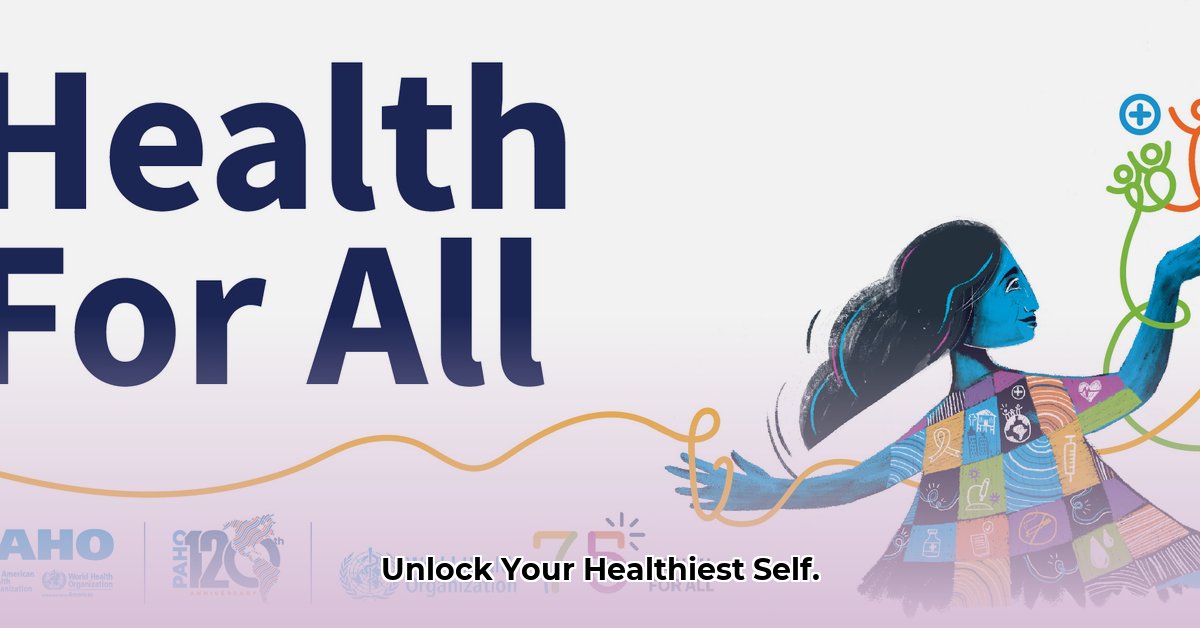Want to feel your best and perform at your peak? It can be tough to figure out where to start with all the health advice out there. This article explores the world of digital health – apps, wearable technology, and programs designed to help you achieve your personal wellness goals. We’ll compare options, look at what works for long-term health improvements, and discuss cost, regulations, and data privacy. This will cover finding the right program and making it a sustainable part of your life, so you can create a healthy routine that sticks.
Health Kick: Your Personalized Path to Wellness in the Digital Age
The way we approach health is changing. Forget the old “one-size-fits-all” approach to wellness – today, we’re seeing a surge in personalized health plans, completely tailored to individual needs. It’s like having a health coach in your pocket, guiding you towards your specific goals and unlocking the secret to sustainable lifestyle changes. Think of companies like HealthKick and GoKick: both offer different ways to improve your well-being, showing us the range of options available. HealthKick might focus on overall wellness, offering mindfulness exercises, personalized workout plans, and healthy recipes, while GoKick could offer more targeted medical solutions, like connecting you with doctors for prescription medications and performance enhancement strategies.
However, with these options comes a lot of questions. How well do these digital tools really work? Can everyone access them easily? What are the rules and regulations surrounding this rapidly evolving field? What about data privacy? Let’s dive in.
Understanding Effectiveness, Accessibility, and Long-Term Health Improvements
The demand for personalized health plans is skyrocketing. Companies like HealthKick have seen success with employee wellness programs, offering personalized nutrition plans, on-demand fitness classes, and stress management resources. GoKick has shown positive results in helping people manage anxiety and optimize performance through personalized medicine. Clinical trials are ongoing to further validate the efficacy of these digital interventions, particularly in areas like chronic disease management and mental health.
It’s promising! However, it’s important to remember that we need more research to fully understand the long-term effects of these digital interventions. We need more solid scientific studies to back up the claims and compare different platforms. Plus, not everyone has equal access to technology and these digital services. Some people might not have the necessary devices, reliable internet access, or digital literacy skills, creating a digital divide that could actually widen existing health inequalities and limit the impact of digital solutions. This is a serious concern. How can we make sure everyone benefits from this new wave of personalized wellness, ensuring equitable access for all?
- More research is needed to fully understand the long-term effects of digital health interventions and how they compare to traditional methods.
- Unequal access to technology and digital literacy can widen existing health inequalities.
- Solid scientific studies are needed to validate the claims of personalized health plans and demonstrate their effectiveness across diverse populations.
Navigating the Rules: Policy and Regulatory Landscape of Digital Health Platforms
The regulatory side of digital health is evolving, but is becoming more defined. For companies like GoKick, which offers prescription medications, meeting FDA standards, ensuring proper liability coverage, and adhering to HIPAA regulations regarding patient data privacy are crucial. The process of getting approval for new technologies, particularly those based on artificial intelligence and machine learning, can be complex. Even those companies like HealthKick, which focus on general wellness, might find themselves facing regulatory scrutiny depending on the specific services they offer, particularly regarding data privacy and security. This uncertainty makes things challenging for both the companies creating these services and the people using them. This complexity affects the future of digital medicine and the ability of companies to innovate. Clear guidelines from regulatory bodies are essential to foster innovation while protecting consumers.
Holistic or Specialized: Finding the Right Approach to Personalized Medicine
HealthKick and GoKick represent different approaches to the same goal: better health. HealthKick leans towards holistic wellness, focusing on things like nutrition, exercise, mindfulness, and stress management. GoKick, on the other hand, offers more specialized, medically-focused interventions, such as prescription medications for specific conditions like anxiety or insomnia, and performance optimization strategies. Both approaches serve a purpose, appealing to different groups of people with varying needs and preferences. The future of personalized wellness likely lies in finding a way for these different approaches to work together, creating a more integrated healthcare system, incorporating the benefits of virtual care and traditional medical practices. Instead of competition, we should expect collaboration to create a transformative impact on individual health journeys. This integrated approach will leverage the strengths of both holistic and specialized interventions, providing a comprehensive and tailored experience for each individual.
Making it Work: Actionable Steps for Stakeholders in the Personalized Health Movement
Let’s take a look at what different groups can do to help the personalized health movement grow in a responsible and effective way, promoting data-driven healthcare and responsible innovation.
| Stakeholder | Short-Term Actions (0-1 year) | Long-Term Actions (3-5 years) |
|---|---|---|
| Digital Health Platforms | Focus on data security and privacy; conduct small-scale studies to measure effectiveness; partner with healthcare providers; actively solicit user feedback and adapt services; ensure accessibility across different devices and internet speeds. | Conduct large-scale clinical trials; develop smarter AI algorithms that minimize bias; proactively adapt to changing regulations; explore international expansion; integrate with electronic health records. |
| Healthcare Providers | Explore and pilot digital health platforms; track patient outcomes; identify ways to integrate digital tools with existing practices; train staff on new technologies and cybersecurity best practices. | Develop standardized protocols for using digital health platforms; participate in clinical trials; expand telehealth services; invest in robust digital infrastructure and data analytics capabilities. |
| Regulators (e.g., FDA) | Establish clear guidelines for data privacy and security; streamline the approval process for digital health technologies; fund research on the impact of these technologies on health outcomes and healthcare costs. | Develop a comprehensive framework for personalized medicine and AI in healthcare; foster collaboration between companies and researchers; address health disparities in access to digital health; collaborate with international regulatory bodies. |
| Consumers | Research different programs; verify trustworthiness and safety; protect personal data; use platforms to complement other types of care; prioritize evidence-based programs; be mindful of sharing personal data. | Advocate for fair pricing and equal access; engage in research studies; demand high data security standards; become informed about digital health technologies and their potential benefits and risks. |
The Future of Your Health Journey and the Role of Digital Therapeutic Solutions
The world of digital health is constantly evolving, offering amazing potential for improving our health and well-being. By addressing the questions of effectiveness, access, regulation, and data privacy, we can collectively pave the way for a healthier future for everyone. Imagine a health plan uniquely designed for you, enhanced by technology, and guided by responsible innovation. The journey towards personalized wellness is just beginning, embracing new opportunities and challenges in the digital health landscape. Digital therapeutic solutions, which deliver evidence-based interventions through software, will play an increasingly important role in managing chronic conditions and promoting mental health.
How to Ensure Equitable Access to Personalized Digital Health Interventions
Key Takeaways:
- Digital health’s potential to improve healthcare is undeniable, but current strategies often widen existing health disparities.
- Addressing the digital divide requires a comprehensive, multi-pronged approach targeting both individual and systemic challenges.
- Focusing on upstream interventions—awareness, navigation, digital literacy, culturally appropriate care—is crucial for equitable outcomes.
- Policymakers, funders, healthcare providers, technology developers, and community organizations all have vital roles to play.
- Careful consideration of ethical implications, bias in algorithms, and data privacy is paramount.
Understanding the Digital Divide in Healthcare and its Impact on Underrepresented Communities
We all crave personalized health solutions, right? But is everyone truly getting equal access to these digital tools that promise better health? Sadly, no. The digital divide—the gap between those who have access to technology, digital literacy, and reliable internet connectivity, and those who don’t—plays a significant role in healthcare equity and exacerbates socioeconomic disparities. This isn’t merely about owning a smartphone; it’s about the skills and knowledge to effectively use digital tools to manage health. Think of it like a highway system: some communities have well-maintained superhighways to healthcare, while others are stuck on bumpy dirt roads. Addressing the digital divide requires an understanding of social determinants of health.
Upstream vs. Downstream Interventions: A Crucial Distinction in Personalized Healthcare
Many digital health initiatives focus on downstream interventions – things like telehealth appointments. While helpful, focusing solely on these approaches often misses the mark when it comes to true equity. We need to concentrate on upstream interventions first—the foundational elements that allow people to even use those downstream services. This means focusing on:
- Raising awareness: Educating communities about available digital health resources and telehealth services, utilizing trusted community leaders and culturally sensitive communication strategies.
- Improving digital literacy: Providing training and support to help people understand and use these digital tools, fostering patient empowerment and building confidence in navigating the digital health landscape.
- Ensuring culturally appropriate care: Designing and delivering digital health interventions that are relevant and accessible to diverse populations. This includes language support, culturally sensitive design, considerations for differing health beliefs, promoting inclusive healthcare, and addressing potential biases
- Affordable Employee Wellness Fair Ideas for Any Budget - December 14, 2025
- Employee Wellness Programs Strategically Benefit Employee Health And Retention - December 13, 2025
- Health and Wellbeing Companies Driving Employee Engagement and Productivity - December 13, 2025
















